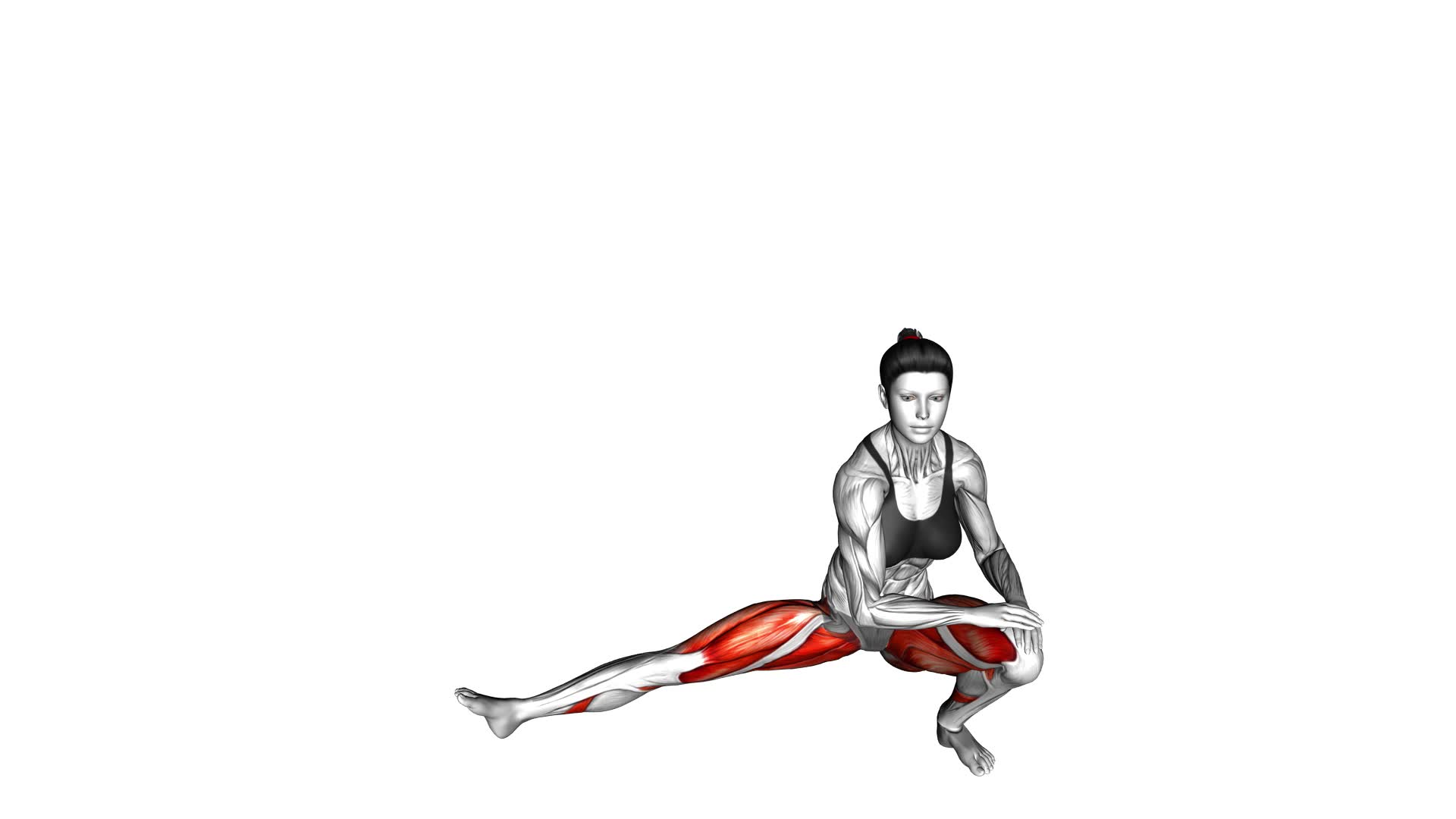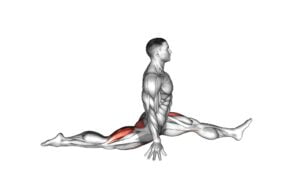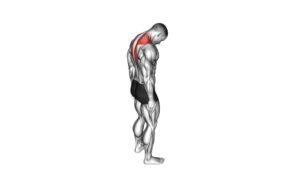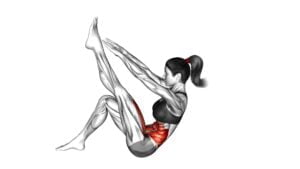Abduction Of One Leg Flexion Stretch (female) – Video Exercise Guide & Tips

Are you looking to improve your flexibility and strengthen your legs?
Watch This Exercise Video
Then the Abduction of One Leg Flexion Stretch is perfect for you! In this video exercise guide, we will show you the proper form and provide helpful tips to get the most out of this stretch.
Whether you are a beginner or at an advanced fitness level, we have variations and modifications to suit your needs. Avoid common mistakes and achieve better results with this effective stretch.
Let's get started!
Key Takeaways
- Abduction of one leg flexion stretch increases range of motion in hip joints.
- This stretch improves flexibility for activities like running and dancing.
- It prevents muscle imbalances in hips and inner thighs.
- Engaging the core, maintaining proper alignment, and gradually increasing intensity are key for getting the most out of this stretch.
Proper Form for Abduction Stretch
To perform the abduction stretch with proper form, you should begin by lying on your back and placing one leg in a flexed position. This stretch primarily targets the muscles in your hips and inner thighs.
Many people make common mistakes when performing this stretch, such as not keeping their back flat on the ground or not fully engaging their core muscles. To avoid these mistakes, make sure to keep your back pressed firmly against the ground throughout the entire stretch. Additionally, engage your core by gently pulling your belly button towards your spine. This will help stabilize your lower back and prevent any unnecessary strain or discomfort.
As you begin the stretch, slowly lower your leg out to the side, keeping it straight and maintaining control of the movement. Only go as far as you can comfortably without feeling any pain or discomfort. Hold the stretch for about 30 seconds, then slowly return your leg to the starting position.
Repeat the stretch on the other leg to maintain balance and symmetry in your stretching routine. By following these proper techniques, you can effectively stretch your hip and inner thigh muscles while minimizing the risk of injury.
Benefits of One Leg Flexion Stretch
The one leg flexion stretch offers several benefits for improving flexibility and strengthening the muscles in your hips and inner thighs. By regularly performing this stretch, you can significantly increase your range of motion in your hip joints, allowing for greater flexibility in activities such as running, dancing, and even everyday movements like bending down to pick something up.
In addition to improving flexibility, the one leg flexion stretch also helps to prevent muscle imbalances. Imbalances in the muscles surrounding the hips and inner thighs can lead to poor posture, decreased stability, and increased risk of injury. By targeting these specific muscle groups, the stretch helps to ensure that they're equally strong and flexible, reducing the likelihood of muscle imbalances.
When performing the one leg flexion stretch, it's important to maintain proper form and technique. This involves keeping your back straight, engaging your core muscles, and avoiding any excessive bouncing or jerking movements. Gradually increasing the intensity and duration of the stretch over time will further enhance its benefits.
Incorporating the one leg flexion stretch into your regular exercise routine won't only improve your flexibility but also contribute to overall muscle balance and prevent potential injuries. So, take the time to include this stretch in your workouts and reap the rewards of improved flexibility and reduced muscle imbalances.
Variations and Modifications for Different Fitness Levels
To adapt the one leg flexion stretch for different fitness levels, you can modify the intensity and range of motion.
Depending on your current level of fitness, you may need to adjust the difficulty of the exercise. For beginners, it's recommended to start with a smaller range of motion and lower intensity. This can be achieved by using a chair or wall for support. Simply stand next to the chair or wall and lift one leg to the side, keeping it straight.
As you become more comfortable with the exercise, you can gradually increase the range of motion by lifting your leg higher and holding the position for longer periods of time. For those at an intermediate or advanced fitness level, you can add additional challenges to the exercise by using resistance bands or ankle weights. These tools can increase the resistance and make the exercise more challenging.
By incorporating different equipment and advanced modifications, you can continue to progress and improve your flexibility and strength.
Transitioning into the next section about tips for getting the most out of your stretch, it's important to remember to listen to your body and only push yourself to a comfortable level.
Tips for Getting the Most Out of Your Stretch
To maximize the benefits of your stretch, focus on proper form and breathing techniques. Here are some tips to help you get the most out of your stretch:
- Maintain proper alignment: Make sure your body is in the correct position throughout the stretch. This will ensure that you target the muscles you want to stretch and avoid unnecessary strain on other areas.
- Engage your core: Activate your core muscles while performing the stretch. This will help stabilize your body and improve your balance, allowing you to achieve a deeper stretch.
- Breathe deeply: Take slow, deep breaths as you hold the stretch. Deep breathing helps to relax your muscles and increase your range of motion, allowing for a more effective stretch.
- Gradually increase intensity: Start with a gentle stretch and gradually increase the intensity as your muscles warm up. Push yourself, but listen to your body and avoid any sharp pain.
By following these tips, you can improve your flexibility and make the most of your stretching techniques. It's important to remember that everyone's body is different, so it's crucial to find what works best for you.
Now, let's move on to the next section and discuss common mistakes to avoid during the abduction stretch.
Common Mistakes to Avoid During the Abduction Stretch
Avoiding these common mistakes will help you get the most out of your abduction stretch. When performing the abduction stretch, it's important to maintain proper form to maximize the benefits and prevent injury. One common mistake to avoid isn't warming up before starting the stretch. Failing to warm up can lead to muscle strains and discomfort during the exercise. Make sure to do some light cardio or dynamic stretches to warm up your muscles before attempting the abduction stretch.
Another common mistake is using too much force or pulling too hard during the stretch. Remember, the goal is to gently stretch the muscles, not to force them into an uncomfortable position. Pulling too hard can strain the muscles and lead to injury. Instead, focus on maintaining a steady and controlled movement throughout the stretch.
Improper alignment is also a common mistake to watch out for. When performing the abduction stretch, make sure to keep your body properly aligned, with your spine straight and your hips squared. Avoid leaning forward or backward, as this can put unnecessary stress on your lower back.
Lastly, rushing through the exercise is another common mistake. Take your time and breathe deeply throughout the stretch to fully relax your muscles and allow for a deeper stretch. Rushing through the exercise can prevent you from getting the full benefits and may increase the risk of injury.
Frequently Asked Questions
What Are Some Alternative Stretches for the Abduction Stretch?
Looking for alternative stretches for the abduction stretch?
Well, incorporating the abduction stretch into your full body stretching routine has many benefits. It helps improve flexibility in your hips, strengthens your core, and enhances your balance.
As for alternatives, you can try the seated butterfly stretch, the standing hip abduction stretch, or the lying hip abduction stretch. These stretches target the same muscles as the abduction stretch and can be great additions to your routine.
How Often Should I Perform the One Leg Flexion Stretch in Order to See Results?
To see results from the one leg flexion stretch, you need to perform it with the right frequency. The effectiveness of this stretch depends on how often you do it.
Incorporate the one leg flexion stretch into your routine at least three times a week. This will give your muscles enough time to recover and adapt to the stretch.
Consistency is key, so stick to this frequency to see improvements in flexibility and mobility.
Can the Abduction Stretch Help With Improving Flexibility in Other Areas of the Body?
Incorporating the abduction stretch into your daily workout routine can have several benefits for improving flexibility in different areas of your body.
This stretch specifically targets the hip abductor muscles, which play a crucial role in maintaining stability and proper alignment.
By regularly performing the abduction stretch, you can enhance your overall flexibility and range of motion.
It's important to note that you can modify this stretch to suit your fitness level by adjusting the intensity and duration.
Are There Any Specific Warm-Up Exercises That Should Be Done Before Attempting the One Leg Flexion Stretch?
Before attempting the one leg flexion stretch, it's important to perform specific warm-up exercises to prepare your muscles and joints. These exercises can include dynamic stretches, such as leg swings and hip rotations, as well as light cardiovascular activities like jogging or jumping jacks.
Warm-up exercises increase blood flow to the muscles, improve flexibility, and reduce the risk of injury. Incorporating these warm-up exercises into your routine will enhance the benefits of the one leg flexion stretch.
Can the Abduction Stretch Be Beneficial for Individuals With Certain Injuries or Medical Conditions?
The abduction stretch can be beneficial for individuals with certain injuries or medical conditions. However, it's important to be aware of potential risks and take necessary precautions.
If you have any existing injuries or medical conditions, it's recommended to consult with a healthcare professional before attempting this stretch. They can provide guidance on modified or assisted versions of the stretch that can be beneficial for individuals with limited mobility or physical limitations.
Conclusion
In conclusion, the abduction of one leg flexion stretch is a beneficial exercise for improving flexibility and strengthening the hip muscles. By performing this stretch with proper form and incorporating variations to suit different fitness levels, individuals can maximize the benefits of the stretch.
Remember to take note of common mistakes to avoid and follow the tips provided to ensure you get the most out of your stretch routine.
Incorporate this stretch into your fitness regimen for improved flexibility and overall strength.

Author
Years ago, the spark of my life’s passion ignited in my mind the moment I stepped into the local gym for the first time. The inaugural bead of perspiration, the initial endeavor, the very first surge of endorphins, and a sense of pride that washed over me post-workout marked the beginning of my deep-seated interest in strength sports, fitness, and sports nutrition. This very curiosity blossomed rapidly into a profound fascination, propelling me to earn a Master’s degree in Physical Education from the Academy of Physical Education in Krakow, followed by a Sports Manager diploma from the Jagiellonian University. My journey of growth led me to gain more specialized qualifications, such as being a certified personal trainer with a focus on sports dietetics, a lifeguard, and an instructor for wellness and corrective gymnastics. Theoretical knowledge paired seamlessly with practical experience, reinforcing my belief that the transformation of individuals under my guidance was also a reflection of my personal growth. This belief holds true even today. Each day, I strive to push the boundaries and explore new realms. These realms gently elevate me to greater heights. The unique combination of passion for my field and the continuous quest for growth fuels my drive to break new ground.







